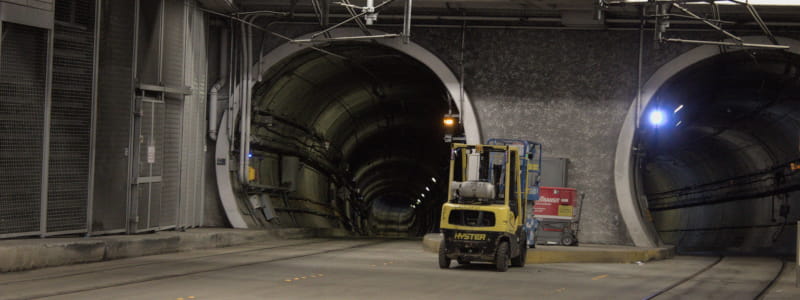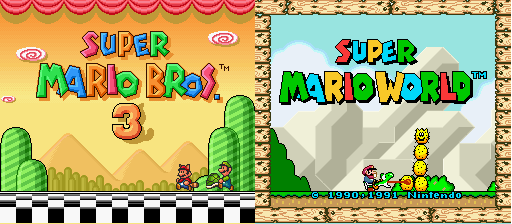
Since my deepest youth I always considered Super Mario World to be better than Super Mario Bros. 3; however, in the past few years, & ’specially recently as I’ve been looking @ Super Mario Bros. 3’s level design for ideas for my own sloppy mess o’ a game, that certainty has withered.
My reasons for preferring Super Mario World was ne’er quite fair: ’twas the 1st game I e’er played, coming out 1 month before I was born. It didn’t beat the All-Stars version o’ Super Mario Bros. 3 by much, — to the point that I’m not 100% sure All-Stars wasn’t the 1st game I played — but the fact that I started with both round the same time shows how I missed the point when Super Mario Bros. 3 1st came out, a year before Super Mario World, when ’twas perhaps mo’ revolutionary.
To my younger mind, Super Mario Bros. 3 was quaint in its limits: you couldn’t re-enter levels you’ve already beaten, you couldn’t move freely ’tween worlds without using scarce flutes, & you could only save to keep the progress since the beginning o’ the world you were in1, as compared to Super Mario World, wherein you could save virtually anywhere so long as you could beat a Ghost House ’gain ( which meant going back to Donut Plains & beating “Donut Ghost House” ).
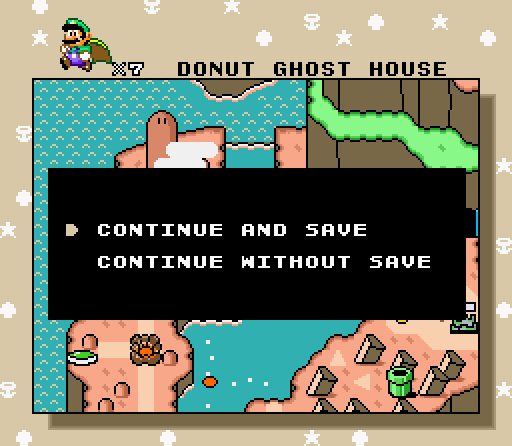
Some hate these additions ’cause they weaken the “challenge” o’ Super Mario World, but I ne’er cared that much for “challenge” — in this case, mere inconvenience. 1st, if one wanted, one could easily just ne’er save or ne’er go back to previous levels, or e’en go farther than vanilla Super Mario Bros. 3 by refusing to collect power-ups or gain any points ( ascetic run ). People also complain ’bout the cape allowing one to fly o’er entire levels for the same reason. ’Gain, nobody’s forcing them to use the cape feather to fly o’er levels. I’m befuddled as to how people can complain ’bout having the freedom to do something — as if they can’t trust themselves to use their toy the “correct way” & need some game designer dictator to tell them how the play.
This is why I ne’er liked the obsession video games have with “challenge”: what usually ends up to be an obsession with work & tedium. This is why I find so many games, ol’ & new, intolerable: they require the player to do so many chores to do the things they want to do, as if paying $40 or mo’ wasn’t ’nough to earn the right to have fun.
To be fair, this isn’t something that’s intrinsically linked with difficulty. For instance, tutorials, the scourge o’ modern games, is 1 o’ the most annoying & common chores2. But making limits “challenging” doesn’t make them any less annoying as limits.
What I always liked ’bout video games was the feeling o’ exploration, which is something Super Mario World did wonderfully. No 2-D platformer has e’er created an o’erworld as memorable or as fun to explore. For Super Mario World, the fun wasn’t going straight from start to finish, but exploring levels for secrets. The secret exits were certainly the most memorable part o’ the game:
-
The path to the “Top Secret Area” found by flying up to the ceiling @ the start o’ “Donut Ghost House”;
-
the split path after the 1st level o’ “Vanilla Dome”;
-
the secret exit to “Cheese Bridge” found by Yoshi jumping under the main gate to find ’nother gate hidden ’hind it, which lead to “Soda Lake”, the only level with Torpedo Teds;
-
the secret exit to “Chocolate Island 2”, found by collecting a certain # o’ coins & going quickly ’nough;
-
the secret exit to “Chocolate Island 3”, which was the only way to proceed, since the regular exit trollishly caused you to go in a pointless circle back to “Chocolate Island 3”.
-
the split path in “Valley of Bowser” that led to a back door to Bowser’s Castle;
-
the secret exit to “Valley of Bowser 4”, gotten by getting to the end without losing Yoshi so you can eat the key through the wall;
-
&, ’course, the entire Star Road & Special World3.
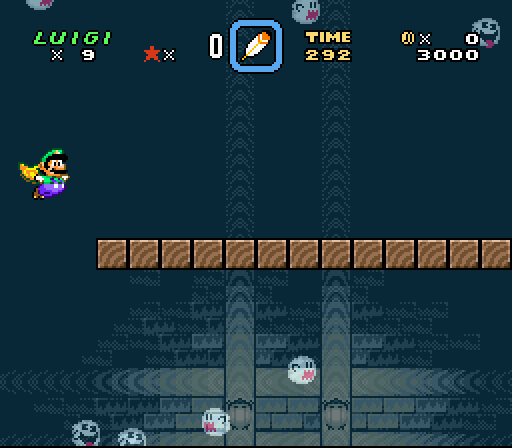
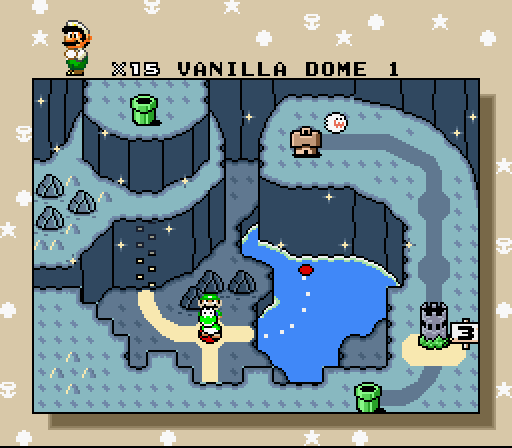
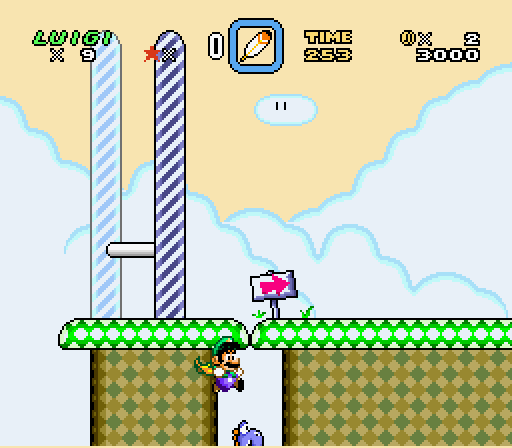
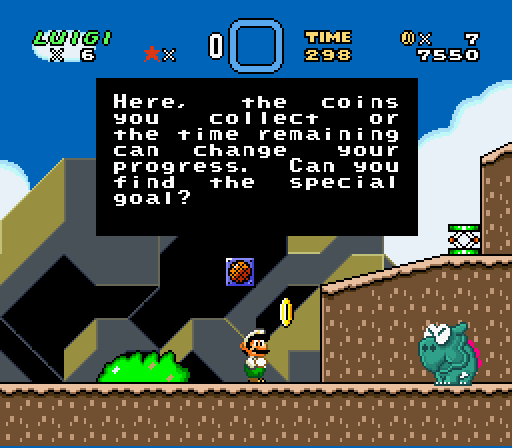
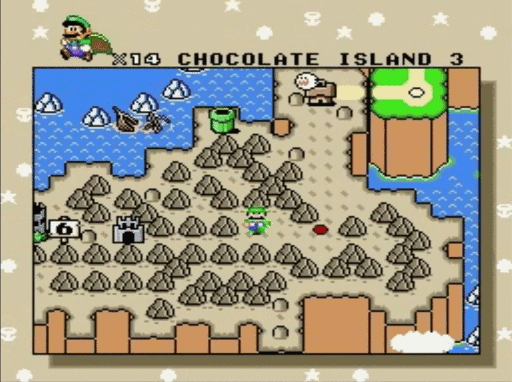
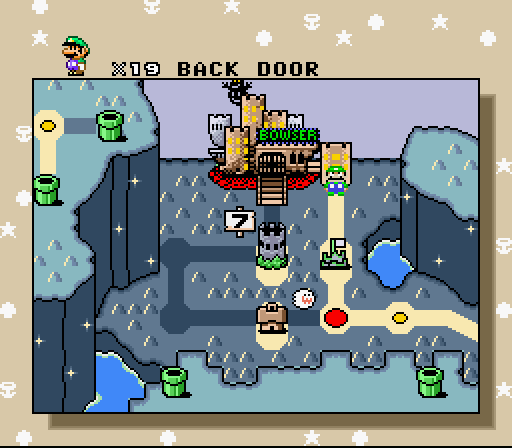
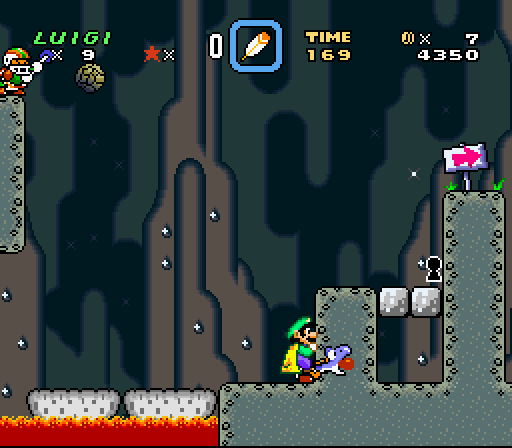
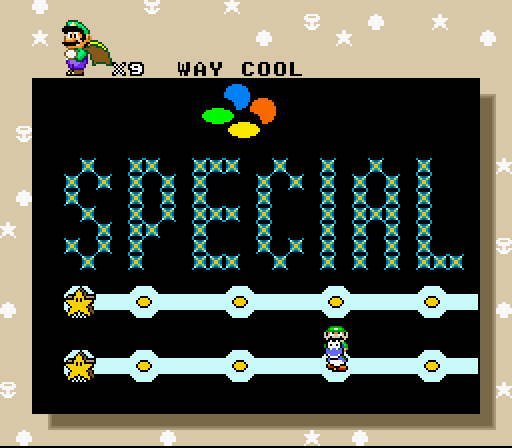
Actually, 1 o’ the coolest things ’bout Super Mario World’s o’erworld was that the “worlds” weren’t cleanly divided as others, making it feel mo’ open & organic. There was something teasingly fun ’bout entering “Valley of Bowser” from “Donut Plains” for a single secret level found on a high cliff through a pipe, only to be unable to reach the rest o’ “Valley of Bowser”.
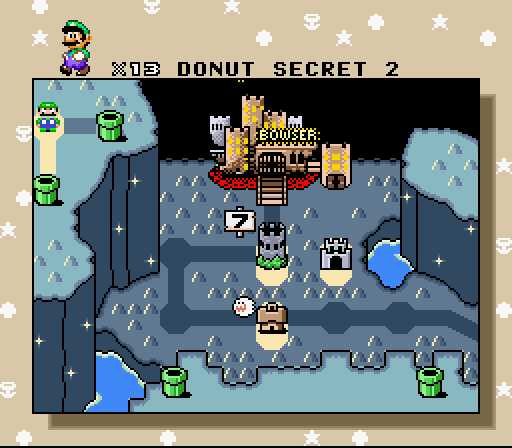
To be fair, Super Mario Bros. 3’s map wasn’t completely superfluous. In fact, in many ways, it had mo’ interactivity than Super Mario World’s, & ’twas the 1st Mario game to have a map:
-
the many sliding image & memory minigames;
- The coin ships & white mushroom houses with obscure requirements to unlock them on the map.
-
the Hammer/Boomerang/Sledge/Fire Bros. battles;
-
the bridges & canoe in “Sea Side”;
-
the way the airship moved to a different place on the map if you lost, which affected the strategic value o’ how you clear the path to it;
-
the way “Sky Land” was split into 2 maps, found by passing through a spiral tower;
-
& the way one could use the Hammer item to find secret corners o’ a world map.
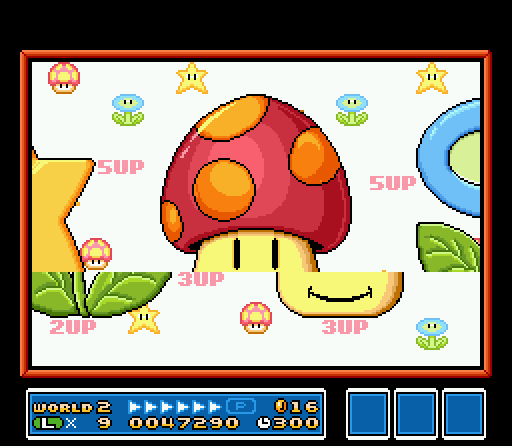
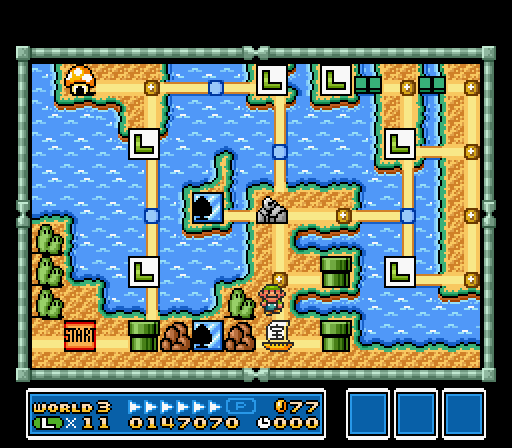
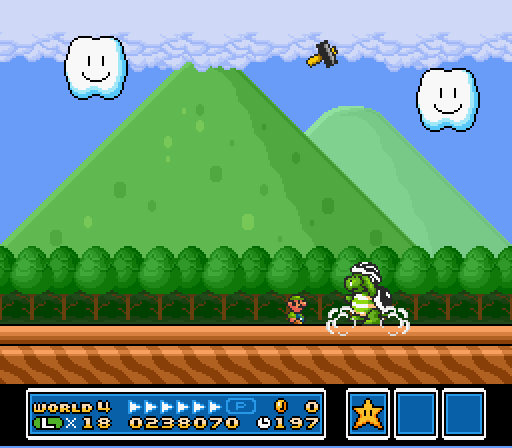
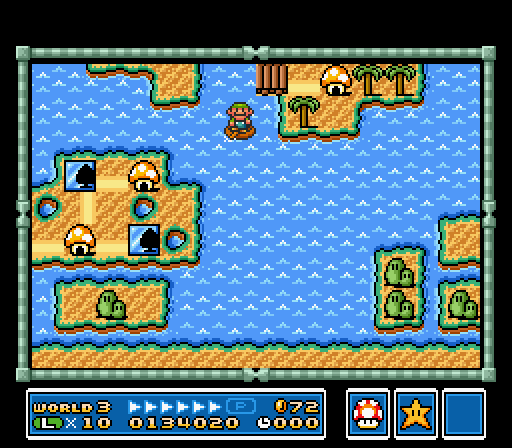
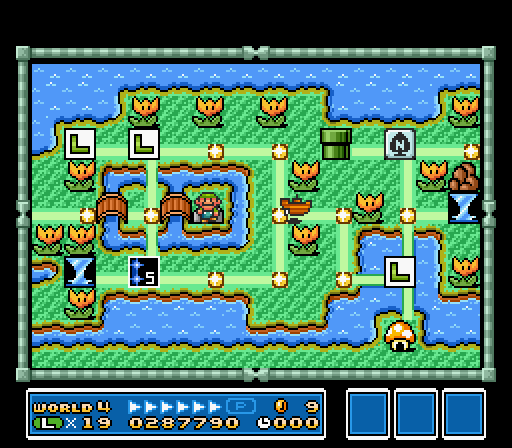
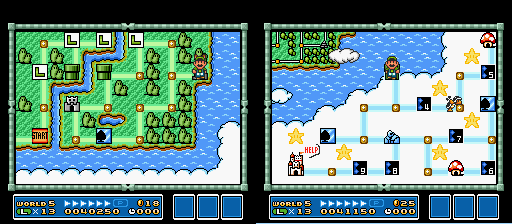
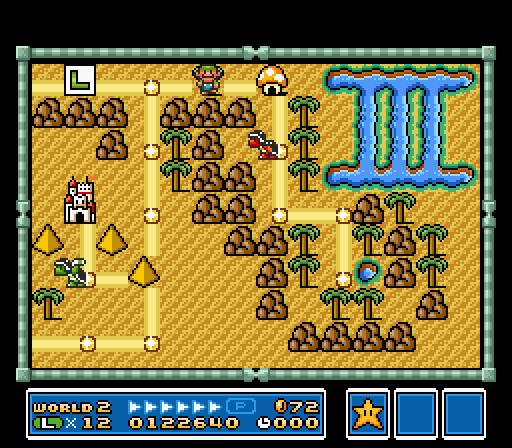
The world map also had split paths sometimes; though these usually just allowed one to skip certain levels — & the completionist in me ne’er wants to do that.
Also, Super Mario Bros. 3’s worlds had mo’ meaningful themes, which made them somewhat mo’ memorable. World mostly has plain & cave worlds, with 1 forest world & 2 “anything goes” maps. Furthermo’, the cave world theme is rendered meaningless by the fact that there are cave levels in the plain worlds, too. Plus, they don’t e’en stick to the themes: cave worlds sometimes have outside levels in them, albeit @ night. This can make Super Mario World levels look samey, which I’ll get to when I talk ’bout aesthetics. While Super Mario Bros. 3’s themes are trite, — which is why their repetition in the New Super Mario Bros. games was annoying — @ the time having themed worlds was in itself still quite fresh, & it still managed to be rather clever with “Big Island” & “Pipe Maze” themes, as well as the artillery level themes.
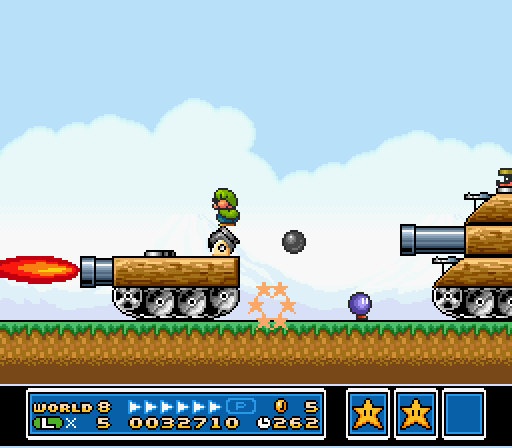
Super Mario Bros. 3 also has a ton o’ fun quirks thrown into it, many o’ which don’t reappear in Super Mario World:
-
The rare power-ups, such as the Tanuki Suit, Hammer Bros. Suit, the Frog Suit, & Kuribo’s Shoe;
-
Boss Bass, which leaps up & eats you;
-
the mother Goomba with all the baby Goombas that don’t harm you, only weaken your jumps;
-
the pipe levels where you can go off 1 side o’ the screen & warp to the other side;
-
those hopping bricks hiding ’mong regular blocks;
-
the fact that the king gives you a different message if you have a Frog Suit or Tanuki Suit, referencing the fact that you looked transformed yourself;
-
& all the aforementioned minigames.
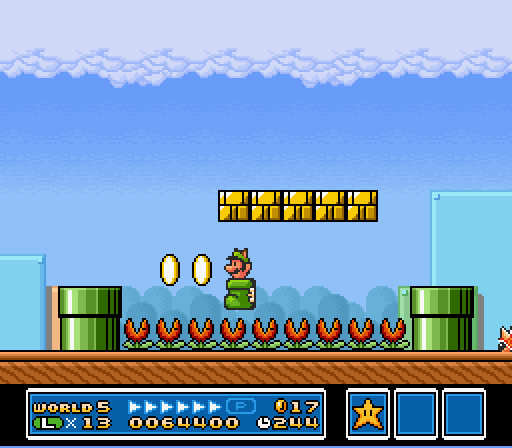
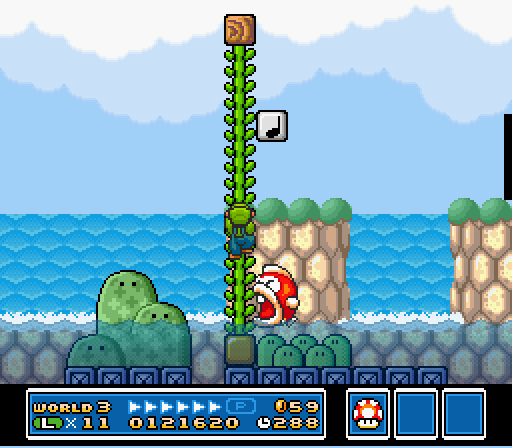
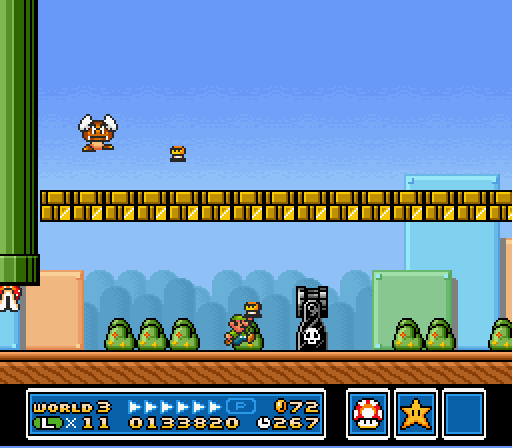
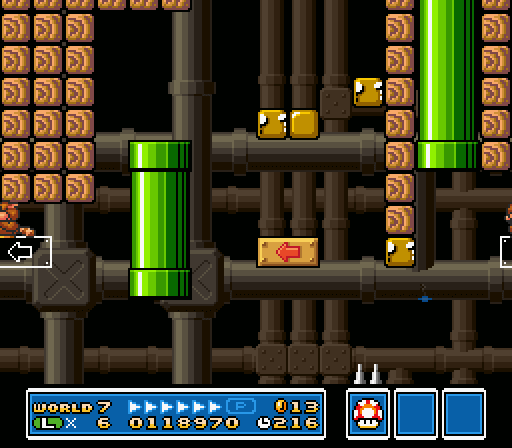
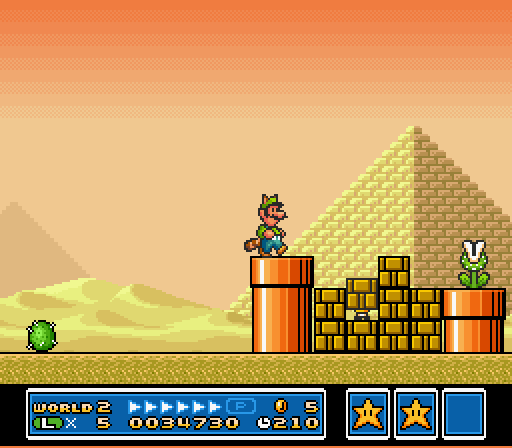
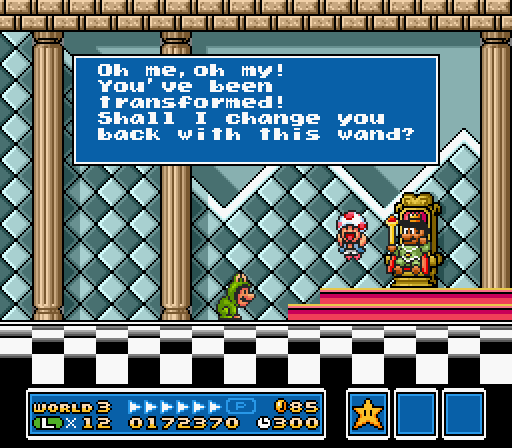
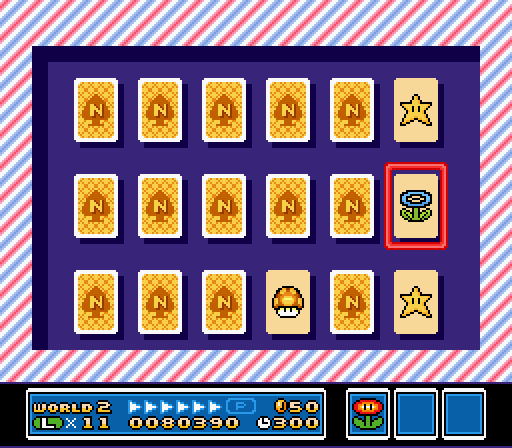
Like with Earthbound, Super Mario Bros. 3 is full o’ all these li’l fun details that it’d take fore’er to try listing them all.
Controls & Gameplay
The controls & physics are ’nother target for contention, with the same common defenses for either: Super Mario World’s controls & physics were tighter & mo’ responsive, while Super Mario Bros. 3 were somewhat slippery ( though not as bad as some people make them out to be ). As with the other issues, Super Mario Bros. 3 defenders praise these mo’ slippery controls as adding to the challenge o’ the game.
I question this. I generally don’t think the challenge o’ a game should come from the unintuitiveness o’ controls or physics, but from the level design & puzzles themselves; however, one could question whether Super Mario Bros. 3’s controls are truly unintuitive or simply mo’ complicated to learn. Either way, people inflate the difference in controls, & I don’t consider it important myself.
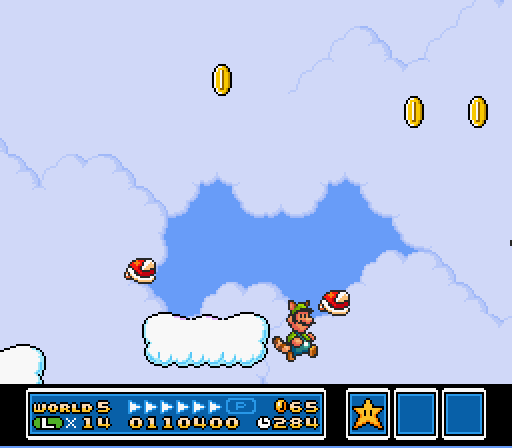
Super Mario World also gave you a spin jump, which could be safely used on most dangers that’d normally hurt regular hops, such as Thwomps, Boos, & Balls & Chains. ’Gain, Super Mario Bros. 3 fans criticize this as neutering the challenge o’ the game, & while I don’t consider it a big problem, I do have to agree with them somewhat. Then ’gain, to be fair, as many hard Super Mario World rom hacks show, spin jumps hardly make it impossible to make things difficult. E’en if Super Mario World didn’t have spin jumps, it’d still probably be easier than Super Mario Bros. 3.
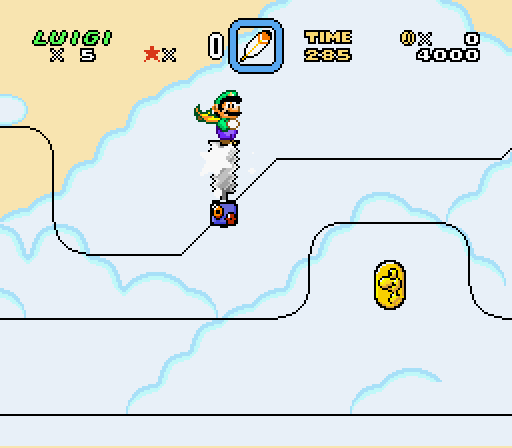
& as I mentioned before, Super Mario World gives you a cape, which can be used to fly o’er some levels, as opposed to the Raccoon Leaf & Tanuki Suit, which had limited flight ( mo’ like a super high jump & a glide ), & rare P-Wings & Jugem’s Clouds, which could be used to skip levels, & which could end up wasted if the player got game o’er & lost their level progress. Jugem’s Cloud, which outright let you skip levels, as opposed to P-Wings, which just let you have infinite flight, didn’t count a stage as beaten, so if you lost to the next stage, you’d get sent to the last beaten stage, which is before the skipped level, effectively wasting the Jugem’s Cloud. Due to the inability to return to past levels, Super Mario Bros. 3 was mo’ sparing with power-ups, though clever players could stock up on power-ups by exploiting a mechanic ironically meant to make things harder: the fact that game o’ers reset the world one’s on, while still letting players keep their items.
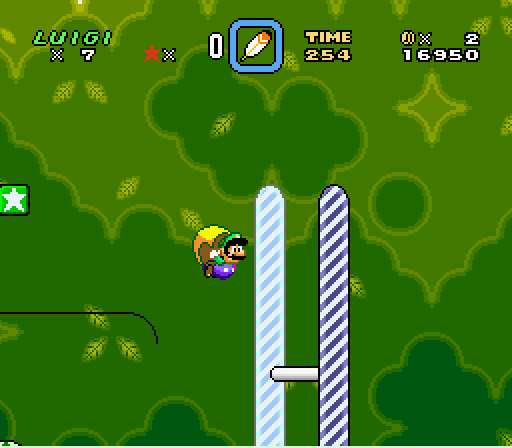
’Gain, while none o’ these issues are that important, I do have to give credit to the Super Mario Bros. 3 defenders. The scarceness o’ power-ups makes the rare & strong power-ups, like the Tanuki Suit & Hammer Bro Suit feel mo’ exciting & special, as well as making the mo’ mundane power-ups, like the fire flower, useful. In Super Mario World, there’s rarely a good reason not to have a cape, ’less one’s purposely going for challenge; in Super Mario Bros. 3, one may be stuck with vulgar fire flowers & mushrooms, challenging them to adapt. This is a challenge I can respect: one not done simply through inconvenience just ’cause I don’t have unlimited time, but due to different contexts. & the “exploit” I mentioned for stocking up items is actually mo’ clever than Super Mario World’s unsubtle method, & is a nice way to be easy to players who get game o’er. One could think o’ it as a less potent form o’ the “Super Guide” or “Shiny Leaf”, or whatever they called that thing the game gives you to humiliate you4.
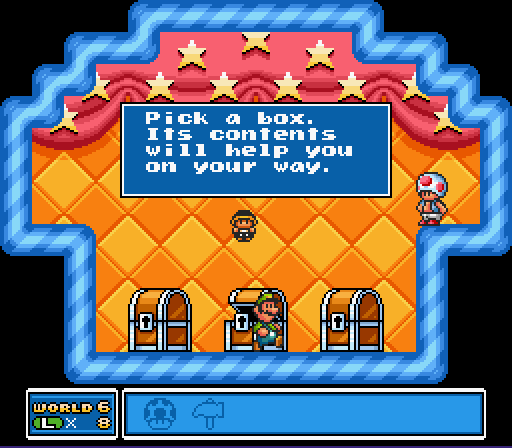
All that said, people o’erstate this difficulty difference. While I agree with the grumbles gainst Super Mario Bros. 3’s inconveniences, such as lack o’ saves or the inability to just load up a beaten game & play whatever level one wants ( ’less one’s playing the Game Boy Advance port with its shitty graphics & sound ); but I’d ne’er call Super Mario Bros. 3 “‘controller through the window’ hard”, as some call it. Quite the opposite: as someone who’ll unabashedly admit that I suck @ games, ’specially NES games, I find it strange that people call Super Mario Bros. 3 hard, ’specially compared to just ’bout every other NES game, ’cept for maybe Kirby’s Adventure5.
In fact, ironically, Super Mario Bros. 3 had some elements that made it easier than World. For instance, the US versions o’ Super Mario Bros. 3 would make Mario or Luigi revert to big after being hit with a better power-up, unlike World.
Moreo’er, most o’ the “tricky” parts o’ Super Mario Bros. 3 are nullified — making them, as I said, mere inconveniences, rather than true challenges. The “threat” o’ game o’er in a game that disallows saving is nullified by the fact that the game just throws lives @ you. You’re guaranteed a life after beating 3 stages, & are likely to get 5 if you can repeat a simple run & jump rhythm that everyone & their gerbil knows @ the end goal. The game also throws power-ups @ you — so many that I usually scramble to use the crappier ones, like Starmen, after I find out that my inventory has filled up. In a twist o’ irony that’d turn Adam Smith on his head, the scarcity o’ the better power-ups like the Tanuki Suit & Hammer Bros Suit only make them not worth the trouble, making you appreciate how sufficient vulgar mushrooms, fire flowers, & raccoon leaves — e’en just good ol’ small Mario — are.
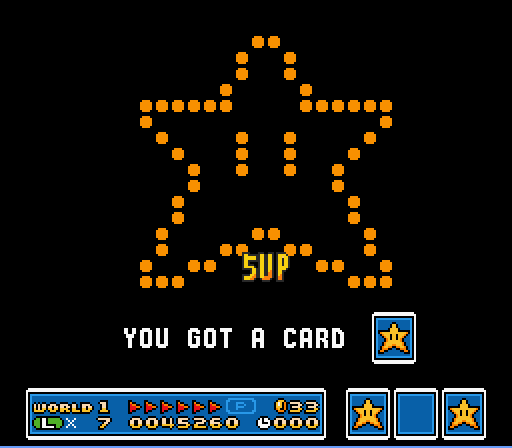
’Sides, you start to realize they’re not that useful, anyway — mo’ cool than anything else. The main challenge in Super Mario Bros. 3 are instadeath pits, not enemies. Hammer Bros. suits are useless for these, & the Tanuki Suit is no better @ dealing with these than the raccoon leaf. & unlike with those, this game throws raccoon leaves @ you.
I rather recently played through this game; & despite fucking round, being a complete klutz & dying all the time, I still made it from “Big Island” to “Ice Land” 6 ( warp whistlin’ ) with a life surplus & plenty o’ items. I was laughing @ how oft I was getting hit ’cause I just wasn’t caring & seeing the game give me yet ’nother raccoon leaf a could blocks afterward. For god’s sake, I think the 1st World 4 level has 2 raccoon leaves. You have to be not trying @ all to get hit twice in that level.
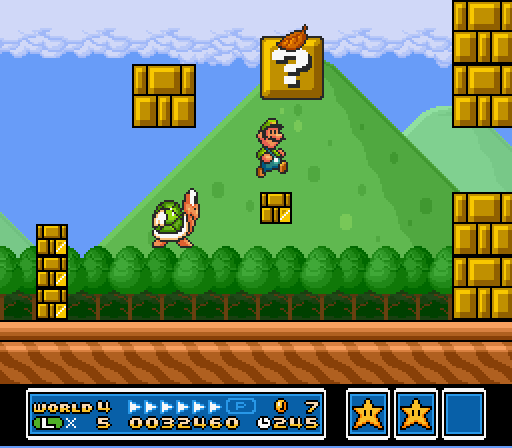
Level Design
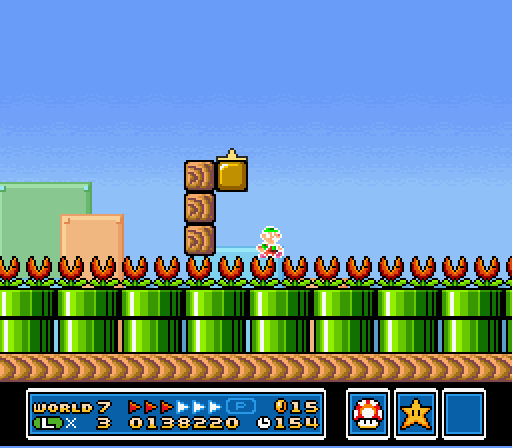
I’m mixed on Super Mario Bros. 3’s level design: They’re shorter, & therefore tighter, whereas World’s can feel fillery sometimes. Some o’ them have exciting quirks that make them memorable: admittedly, no World level has anything as memorable as Kuribo’s Shoe, the race to get to the next star on a long plot o’ plants before your star runs out, the chomps that came out o’ alternating pipes, or Boss Bass. However, Super Mario Bros. 3 also had its share o’ forgettable levels, ’specially in “Sky Land”. 5-8 is pretty much, “Hey, ¿remember Lakitu?”, that could’ve easily existed in the original Super Mario Bros.; 5-9 is just a bunch o’ repetitive jumps with Fire Chomps constantly appearing; 5-6 was just a bunch o’ tiny jumps o’er Parabeetles copied & pasted round. Super Mario Bros. 3 also has tons o’ autoscrollers7, & they’re so slow & boring. Granted, a’least Super Mario Bros. 3’s are short; just the thought o’ going through “Donut Plains 2” twice bores me to a coma. Still, people who claim that Super Mario Bros. 3 was the “absolute king o’ level design” clearly have nostalgia glasses; anyone being honest would admit that both Bros. 3 & World have wrinkles in their level design that reveal their age.
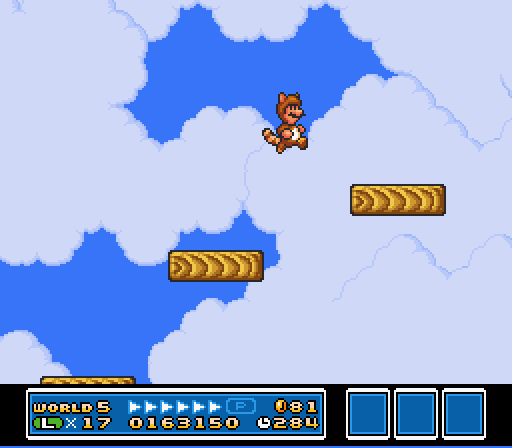
Also, while airships are cooler looking than castles, Super Mario Bros. 3’s airship levels & bosses were samey, & the airships were all autoscrollers, while Super Mario World’s were much mo’ creative. While the airship levels were all simple “dodge a bunch o’ cannons”, Super Mario World used nets, moving blocks, Magikoopas who shoot colored shape magic, & that block snake. Whereas Super Mario Bros. 3 simply had its Koopa Kids bounce round on balls in a small room, Super Mario World had the pipe shell game for the Wendy & Lemmy bosses. & Super Mario Bros. 3’s Bowser fight could ne’er compete with World’s, which is probably the best Bowser fight in history: while 3’s Bowser is your size & simply jumps round & spits fire @ you till he breaks through the floor to the bottom, World’s is in a hulking clown car & swoops round dropping Mecha Koopas & large iron balls.
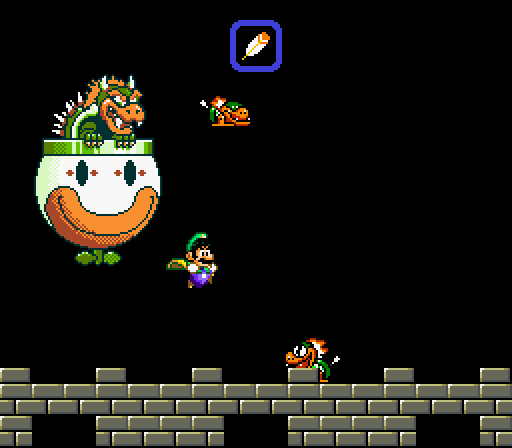
( Ironically, Super Mario Bros. 3’s boss levels & bosses are all much easier than Super Mario World’s, with perhaps the exception o’ the last airship in World 8. )
Graphics
While I always used to prefer Super Mario World in terms o’ gameplay, I always preferred Super Mario Bros. 3’s aesthetics ( e’en the NES version’s ), & still do, no question. Honestly, I always found Super Mario World looked kind o’ ugly: its color palettes are plainer & dingier than Super Mario Bros. 3’s, its sprites sometimes look funky ( don’t get me started on “Galoombas” ), & its level terrain looks plainer. While Super Mario Bros. 3 had checkered floors, wooden blocks suspended by cords, & colored blocks with screws in their corners, World had lots o’ brown dirt. World had truly terrible backgrounds, mostly just a bunch o’ plain hills with spots & simple, repetitive rocks that, though simple, also somehow looks cluttered @ the same time. They’re a tacky middle ’tween a stylish abstract that Super Mario Bros. 3 accomplishes & actual concrete detail. The NES version o’ Super Mario Bros. 3 was mo’ creative with backgrounds, & it didn’t e’en have a separate background layer to work with, such as the constellation o’ mushroom, fire flower, & star outlines in 8-1. In general, 8-1 & 8-2 look better than any Super Mario World level.
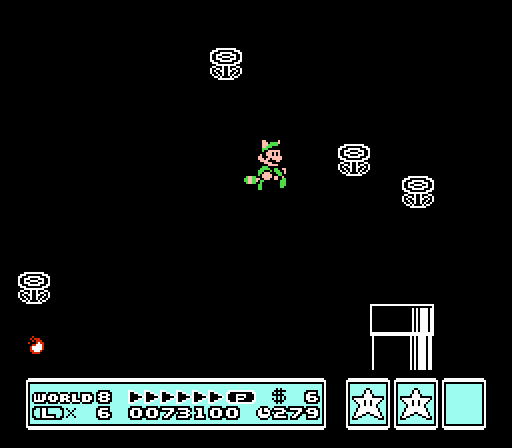
In fact, while I generally prefer Super Mario All-Stars’s aesthetics, e’en the NES Super Mario Bros. 3 had its charms. I have to admit that as I played the All-Stars version o’ Ice Land I began to miss the candy-cane-reminiscent striped backgrounds. Sure, they’re simple compared to the snowy hills; but they had a bizarre abstract heart to them that the mo’ mundane hills don’t have. The snowy hills & firs8, simple themselves with a plastic look, felt like they belonged in a normal cartoon world; the stripped background looks like it belongs in the warped world o’ Super Mario Bros. 3 with colored screw blocks & wooden blocks floating in the sky. Also, I preferred the screws in the corners o’ the ?-block in the NES version mo’ than the rounded blocks in the SNES version, which look misshapen, as if they were factory mistakes.
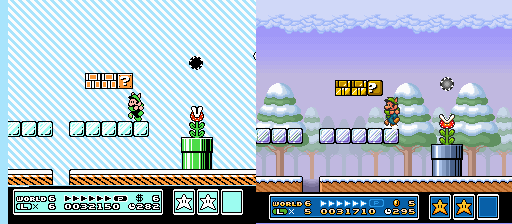
Music
While I love Super Mario World’s map themes — ’specially the def beats o’ “Vanilla Dome”, ( ¿Why has no rapper sampled this yet? ) the sinister “Valley of Bowser”, & the summery jingle o’ “Forest of Illusion” — its level songs can get grating after a while — ’specially since they’re all basically the same song, just with different tempos. Only its “Ghost House” & “Athletic” songs are likeable, & the latter’s still not as good as Super Mario Bros. 3’s. & while it’s nice to get a reprieve from the Super Mario Bros. underground theme, which Super Mario Bros. 3 reuses, Super Mario World’s replacement is blander, ¡& still sneaks a part o’ the other level songs in, as if we haven’t heard that fucking song ’nough! ¡Augh!
However, Super Mario World had better credits & title screen songs — some o’ the best o’ any game9, actually. Super Mario Bros. 3 didn’t e’en have a title screen song in the original NES game. Its final boss theme is also better.
That said, Super Mario Bros. 3 definitely has the better music, o’erall. I can’t think o’ a song I don’t like, & its least good track is better than most o’ the songs in Super Mario World.
Much like with the graphics, I generally prefer the All-Stars renditions. The NES versions are great, — ’gain, better than most o’ the Super Mario World SNES tracks — but the SNES versions are just beefed up with heavier bass & drums for mo’ foreboding sounds. “Airship”, “Boss Battle”, “Bowser”, “Castle of Koopa”, “Fortress”, “Desert Hill”, & “Pipe Maze” — god, “Pipe Maze” is great — ’specially benefit. E’en the o’erused underground theme benefits from the heavy echo effect.
Meanwhile, “Big Island” swells with lush orchestra & “Ice Land”’s echoes make for a mo’ daunting map.
That said, I think I do prefer the NES versions o’ “Athletic” & “Hammer Bros. Battle”, ironically due to the same feature that benefited the aforementioned tracks: I feel these songs are made cloudier by the heavier bass, whereas they sound sharper with the crisper buzz-crunch o’ the NES “piano” keys.
Some o’ the other songs a’least sound close to as good in the NES version. “Ice Land” lacks the foreboding echoes on the NES, but makes up for that with the additional twinkle sounds. Same goes for the click noises in the NES version o’ “Pipe Maze”. “Big Island” sounds a bit punchier, which admittedly fits the theme o’ the map better.
( You know, I ne’er understood the way these 2 Mario games handled music. It’s the opposite o’ how the Donkey Kong Country games did it: while those games had 1 map theme & many level themes, these 2 Mario games have a few level themes & a song for every map. The DKC style makes mo’ sense to me: you’ll be on the map for such a short amount o’ time, it’s rare you’ll get tired o’ its song, whereas you’re in levels for much longer. I would much rather listen to “Vanilla Dome” for 3 minutes than that cave song. )
Conclusion
I told you I hate conclusions.
¿So which do I judge is better? ¿What am I, the Grand Judge o’ Video Games? ¿Who cares what I decree?
Addendum
1 last advantage Super Mario World has o’er Super Mario Bros. 3: the ability to take lives from 1 player & give it to ’nother, which makes it much quicker to rid myself o’ Mario on a “2 player game” — a game wherein I, ’lone, play as the 2nd player, Luigi. As if I’d e’er want to play as shabby ol’ Mario — phhh.
